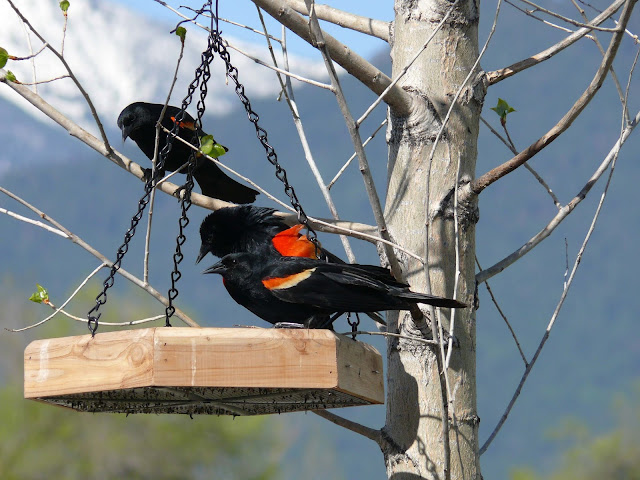When we started our first day at Lee Metcalf National Wildlife Refuge we asked what our duties would be in the visitor center. "Answer questions about the birds and ducks" we were told. That was a pretty frightening order to two people who, when it came to birds knew there were Robins....and all others, and when it came to ducks, Mallards.....and all others. But we found learning to be a challenge we enjoyed, and eventually became fairly knowledgeable.
 |
| Red-winged Blackbird |
At the refuge we had the opportunity to participate in bird banding. When I first heard the term, I visualized a group of marching birds with horns and tubas....but it wasn't that kind of bird band. Instead, we met at the crack of dawn in a wooded area that had "mist nets" (almost invisible) set up. Birds were ensnared, placed in soft cloth bags, and examined/weighed/sampled and asked to fill out a customer
 |
| Bullock's Oriole |
 |
| Cedar Waxwing |
 |
| Pyrrhuloxia |
Also at the Nature Preserve were a pair of Vermilion Flycatchers that would hang around the small trees near the visitor center. We couldn't imagine a better welcoming committee for visitors that these brightly colored beauties.
 |
| Vermilion flycatcher |
Sometimes you find a bird that just doesn't look right. We found this Red Crossbill in New Mexico's Sacramento Mountains. My first thought was that it needed to see an avian orthodontist. Turns out it's supposed to look that way and the crossed beak is helpful in digging out seeds from conifers.
 |
| Red Crossbill |
 |
| Green Jay |
Tropical birds seem to be more colorful than most, and this Green Jay that we spotted in the Rio Grande Valley was a good example. We were visiting the San Bernard Wildlife refuge and saw this Jay complete with red berry to complete the color palette.
While volunteering at the Desert National Wildlife Refuge in Southern Nevada, the Phainopepla, often called the "black Cardinal". It was very common here, feeding on the berries of the Mistletoe growing in the mesquite trees. Unfortunately, the berry seeds aren't digested, and after being passed through the bird, they stick to the tree branches and grow....more mistletoe. It can overwhelm the tree's ability to get enough water and eventually kill it. Regrettably, the Phainopepla are notoriously difficult to potty train.
 |
| Phainopepla |
And finally, the Nature Preserve was close to the Mexican border and in the spring we were treated to dozens of Hummingbirds as they started their spring migration. Our three two-quart feeders would be emptied each day by these hungry little guys...and oh my, the dogfights!
 |
| Rufus, Broad-Billed, Anna, Black-chinned, Violet-crowned |
That's it for now, hope you enjoyed the diversion from boredom. Next time around we'll post pictures of ducks and shorebirds. Until then stay well, keep occupied, and do what you can to help those hurt by this pandemic.
